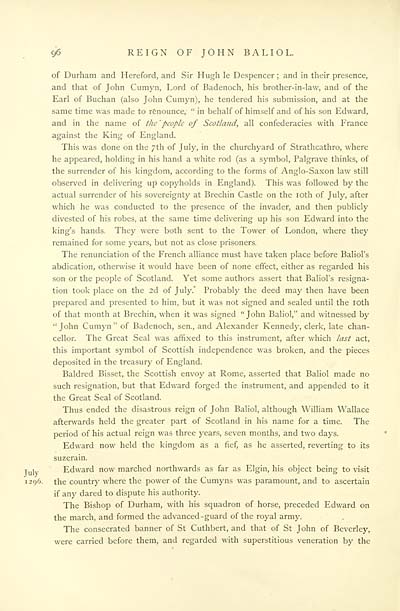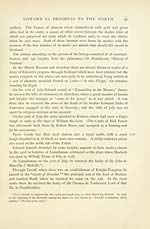Family records of the Bruces and the Cumyns
(108) Page 96
Download files
Complete book:
Individual page:
Thumbnail gallery: Grid view | List view

96 REIGN OF JOHN BALIOL.
of Durham and Hereford, and Sir Hugh le Despencer ; and in their presence,
and that of John Cumyn, Lord of Badenoch, his brother-in-law, and of the
Earl of Buchan (also John Cumyn), he tendered his submission, and at the
same time was made to renounce, "in behalf of himself and of his son Edward,
and in the name of the 'people of Scotland, all confederacies with France
against the King of England.
This was done on the 7th of July, in the churchyard of Strathcathro, where
he appeared, holding in his hand a white rod (as a symbol, Palgrave thinks, of
the surrender of his kingdom, according to the forms of Anglo-Saxon law still
observed in delivering up copyholds in England). This was followed by the
actual surrender of his sovereignty at Brechin Castle on the 10th of July, after
which he was conducted to the presence of the invader, and then publicly
divested of his robes, at the same time delivering up his son Edward into the
king's hands. They were both sent to the Tower of London, where they
remained for some years, but not as close prisoners.
The renunciation of the French alliance must have taken place before Baliol's
abdication, otherwise it would have been of none effect, either as regarded his
son or the people of Scotland. Yet some authors assert that Baliol's resigna-
tion took place on the 2d of July.* Probably the deed may then have been
prepared and presented to him, but it was not signed and sealed until the 10th
of that month at Brechin, when it was signed "John Baliol," and witnessed by
" John Cumyn " of Badenoch, sen., and Alexander Kennedy, clerk, late chan-
cellor. The Great Seal was affixed to this instrument, after which last act,
this important symbol of Scottish independence was broken, and the pieces
deposited in the treasury of England.
Baldred Bisset, the Scottish envoy at Rome, asserted that Baliol made no
such resignation, but that Edward forged the instrument, and appended to it
the Great Seal of Scotland.
Thus ended the disastrous reign of John Baliol, although William Wallace
afterwards held the greater part of Scotland in his name for a time. The
period of his actual reign was three years, seven months, and two days.
Edward now held the kingdom as a fief, as he asserted, reverting to its
suzerain.
t u j v Edward now marched northwards as far as Elgin, his object being to visit
1296. the country where the power of the Cumyns was paramount, and to ascertain
if any dared to dispute his authority.
The Bishop of Durham, with his squadron of horse, preceded Edward on
the march, and formed the advanced -guard of the royal army.
The consecrated banner of St Cuthbert, and that of St John of Beverley,
were carried before them, and regarded with superstitious veneration by the
of Durham and Hereford, and Sir Hugh le Despencer ; and in their presence,
and that of John Cumyn, Lord of Badenoch, his brother-in-law, and of the
Earl of Buchan (also John Cumyn), he tendered his submission, and at the
same time was made to renounce, "in behalf of himself and of his son Edward,
and in the name of the 'people of Scotland, all confederacies with France
against the King of England.
This was done on the 7th of July, in the churchyard of Strathcathro, where
he appeared, holding in his hand a white rod (as a symbol, Palgrave thinks, of
the surrender of his kingdom, according to the forms of Anglo-Saxon law still
observed in delivering up copyholds in England). This was followed by the
actual surrender of his sovereignty at Brechin Castle on the 10th of July, after
which he was conducted to the presence of the invader, and then publicly
divested of his robes, at the same time delivering up his son Edward into the
king's hands. They were both sent to the Tower of London, where they
remained for some years, but not as close prisoners.
The renunciation of the French alliance must have taken place before Baliol's
abdication, otherwise it would have been of none effect, either as regarded his
son or the people of Scotland. Yet some authors assert that Baliol's resigna-
tion took place on the 2d of July.* Probably the deed may then have been
prepared and presented to him, but it was not signed and sealed until the 10th
of that month at Brechin, when it was signed "John Baliol," and witnessed by
" John Cumyn " of Badenoch, sen., and Alexander Kennedy, clerk, late chan-
cellor. The Great Seal was affixed to this instrument, after which last act,
this important symbol of Scottish independence was broken, and the pieces
deposited in the treasury of England.
Baldred Bisset, the Scottish envoy at Rome, asserted that Baliol made no
such resignation, but that Edward forged the instrument, and appended to it
the Great Seal of Scotland.
Thus ended the disastrous reign of John Baliol, although William Wallace
afterwards held the greater part of Scotland in his name for a time. The
period of his actual reign was three years, seven months, and two days.
Edward now held the kingdom as a fief, as he asserted, reverting to its
suzerain.
t u j v Edward now marched northwards as far as Elgin, his object being to visit
1296. the country where the power of the Cumyns was paramount, and to ascertain
if any dared to dispute his authority.
The Bishop of Durham, with his squadron of horse, preceded Edward on
the march, and formed the advanced -guard of the royal army.
The consecrated banner of St Cuthbert, and that of St John of Beverley,
were carried before them, and regarded with superstitious veneration by the
Set display mode to:
![]() Universal Viewer |
Universal Viewer | ![]() Mirador |
Large image | Transcription
Mirador |
Large image | Transcription
Images and transcriptions on this page, including medium image downloads, may be used under the Creative Commons Attribution 4.0 International Licence unless otherwise stated. ![]()
| Histories of Scottish families > Family records of the Bruces and the Cumyns > (108) Page 96 |
|---|
| Permanent URL | https://digital.nls.uk/95072282 |
|---|
| Description | A selection of almost 400 printed items relating to the history of Scottish families, mostly dating from the 19th and early 20th centuries. Includes memoirs, genealogies and clan histories, with a few produced by emigrant families. The earliest family history goes back to AD 916. |
|---|

